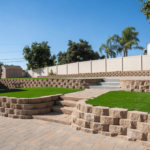Your outdoor area can acquire a classic, natural appeal with the addition of rock landscaping. However, erosion, weather, and other factors might cause your rock garden to lose its allure over time. Don’t worry if you think your landscaping needs some TLC! With the help of this in-depth tutorial, you will be able to revamp your rock landscaping and create a breathtaking, revitalized outdoor haven.
Assessment and Planning
Consider the improvements you wish to make to your outdoor space and evaluate its existing condition before beginning the actual job of reworking your rock landscaping. It is important to take into account various aspects such as the area’s dimensions, the kinds of plants and stones you like to use, and your desired overall design style.
Evaluate Existing Rocks and Plants:
Start by examining the condition of the existing rocks and plants in your landscaping. Identify any damaged or worn-out rocks that need replacement and assess the health of your plants. Decide whether you want to keep certain elements or if a complete overhaul is necessary.
Define Your Vision:
Clarify your vision for the revamped rock landscaping. Consider the style you want, whether it’s a Zen-inspired garden, a desert oasis, or a lush and colorful rock garden. Your vision will guide your plant and rock selection, as well as the overall layout.
Measure and Plan:
Take accurate measurements of the area to ensure you purchase the right amount of rocks and plants. Create a rough sketch or use a design tool to plan the layout of your rock garden. This will help you visualize the end result and make adjustments before starting the physical work.
Rock Selection and Preparation
Once you have a clear plan in place, it’s time to choose new rocks and prepare the area for the transformation.
Choose Appropriate Rocks:
Select rocks that align with your vision and complement the overall aesthetic of your outdoor space. Consider factors such as color, size, and texture. Popular choices include river rocks, boulders, and flagstones. Ensure that the rocks you choose are durable and suitable for your climate.
Remove Old Rocks and Plants:
Begin the redo process by removing the existing rocks and plants. This may involve some manual labor, so use appropriate tools like shovels and wheelbarrows. Dispose of any debris responsibly, and consider recycling or repurposing rocks if they’re still in good condition.
Prepare the Soil:
Take this opportunity to improve the soil quality in your rock garden. Remove any weeds, add organic matter, and level the soil to create a stable foundation for your new landscaping. Consider using landscaping fabric to prevent weed growth and aid in water drainage.
Layout and Design
With a clean slate, it’s time to bring your vision to life by arranging the rocks and planning the layout of your new rock garden.
Experiment with Layout:
Before finalizing the placement of rocks, experiment with different layouts. Arrange the rocks in various configurations to find the most visually appealing arrangement. Pay attention to spacing and balance to create a harmonious design.
Consider Focal Points:
Identify focal points within your rock landscaping, such as a central boulder, a water feature, or a unique plant. Focal points add interest and draw the eye, enhancing the overall aesthetic of the garden.
Create Pathways and Borders:
Define pathways and borders within your rock garden to guide movement and add structure. Use larger rocks to create borders and smaller stones for pathways. This not only enhances the design but also improves accessibility within the space.
Plant Selection and Installation
Now that your rock layout is in place, it’s time to introduce plants that will thrive in your rock garden environment.
Choose Drought-Tolerant Plants:
Select plants that are well-suited to rock landscaping and can thrive in your climate. Drought-tolerant plants, succulents, and groundcovers are excellent choices for rock gardens, as they require minimal water and maintenance.
Consider Color and Texture:
Think about the color palette and texture of the plants you want to incorporate. Contrast and variety in foliage and blooms can enhance the visual appeal of your rock garden. Aim for a balanced mix of colors and textures for a vibrant and dynamic landscape.
Planting Technique:
Dig appropriate-sized holes for each plant, considering their mature size. Add a layer of well-draining soil, plant the chosen vegetation, and water thoroughly. Mulch around the plants to retain moisture and suppress weeds.
Maintenance and Care
Your newly redone rock landscaping requires ongoing care to ensure it thrives and maintains its beauty over time.
Regular Watering:
Even though rock gardens are known for their low-water needs, newly planted vegetation requires regular watering until they establish roots. Once established, most plants in rock gardens thrive with minimal irrigation. Use a drip irrigation system or water deeply and infrequently to encourage deep root growth.
Weed Control:
Keep an eye on weed growth and promptly remove any unwanted plants. The use of landscaping fabric and a layer of mulch can significantly reduce weed growth, making maintenance more manageable.
Pruning and Trimming:
Regularly prune and trim your plants to maintain their shape and prevent overcrowding. This is especially important for groundcovers and spreading plants that can become invasive if left unchecked.
Monitor Drainage:
Check the drainage in your rock garden regularly to ensure water is not pooling in certain areas. Proper drainage is essential to prevent waterlogged soil, which can lead to root rot and other plant diseases.
Lasting Outdoor Retreat
Redoing your rock landscaping can breathe new life into your outdoor space, transforming it into a visually stunning and tranquil haven. You can build a rock garden that endures for many years by carefully evaluating your existing environment, organizing your vision, choosing the appropriate rocks and plants, and carrying out regular maintenance procedures. The secret is to strike a balance between aesthetics and practicalities to create a landscape that expresses your style and flourishes in your particular setting, whether your vision is an oasis full of color or a desert-inspired retreat. If you follow this thorough guidance, you should have no trouble having a rejuvenating and beautiful outdoor vacation.






